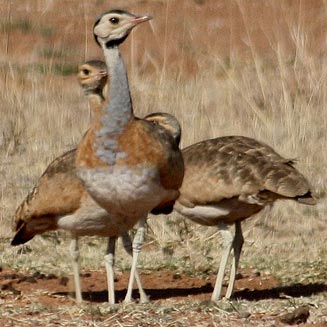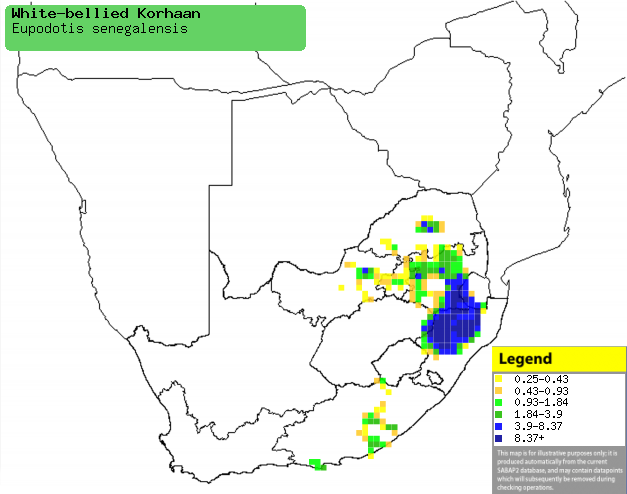|
Eupodotis senegalensis
(Southern white-bellied korhaan, Barrow's korhaan)
[= Eupodotis cafra]
Witpenskorhaan [Afrikaans]; iNgangalu [Zulu]; Mokagatwê
[Tswana]; Senegaltrap [Dutch]; Outarde de Barrow [French]; Weißbauchtrappe
[German]; Abetarda-de-barriga-branca [Portuguese]
Life
> Eukaryotes >
Opisthokonta
> Metazoa (animals) >
Bilateria >
Deuterostomia > Chordata >
Craniata > Vertebrata (vertebrates) > Gnathostomata (jawed
vertebrates) > Teleostomi (teleost fish) > Osteichthyes (bony fish) > Class:
Sarcopterygii (lobe-finned
fish) > Stegocephalia (terrestrial
vertebrates) > Tetrapoda
(four-legged vertebrates) > Reptiliomorpha > Amniota >
Reptilia (reptiles) >
Romeriida > Diapsida > Archosauromorpha > Archosauria >
Dinosauria
(dinosaurs) > Saurischia > Theropoda (bipedal predatory dinosaurs) >
Coelurosauria > Maniraptora > Aves
(birds) >
Order: Gruiformes
> Family: Otitidae
 |
|
|
White-bellied korhaan male (foreground) and
females (backround). [photo Dennis Gerrans
©] |
|
Distribution and habitat
Near-endemic to South Africa, occurring from the Limpopo
Province and adjacent provinces, south through Swaziland to KwaZulu-Natal and
the Eastern Cape. It generally prefers fairly tall, dense sour or mixed
grassland, either open or lightly wooded, occasionally moving into cultivated or
burnt land.
|
 |
|
Distribution of White-bellied korhaan in southern Africa,
based on statistical smoothing of the records from first SA Bird Atlas
Project (©
Animal Demography unit, University of
Cape Town; smoothing by Birgit Erni and Francesca Little). Colours range
from dark blue (most common) through to yellow (least common).
See here for the latest distribution
from the SABAP2. |
Call
Predators and parasites
Movements and migrations
Resident and sedentary.
Food
Omnivorous, feeding on invertebrates, lizards and plant
matter, doing most of its foraging by walking and pecking the ground. The following food items have been recorded
in its diet:
- Animals
- Plants
- green herbage
- grass seeds
- berries
- bulbs
- flowers
Breeding
- Little known, it is probably monogamous and territorial.
- The nest is a simple scrape in the ground between grass tufts.
- Egg-laying season is from October-January, peaking in November.
- It lays 1-2, rarely 3 eggs, which are incubated solely by the female for
about 23 days.
- The chicks are cared for by both parents, leaving the nest soon after
hatching.
Threats
Vulnerable, as its range is contracting in KwaZulu-Natal,
leaving isolated and vulnerable population pockets.
References
-
Hockey PAR, Dean WRJ and Ryan PG 2005. Roberts
- Birds of southern Africa, VIIth ed. The Trustees of the John Voelcker
Bird Book Fund, Cape Town.
|
